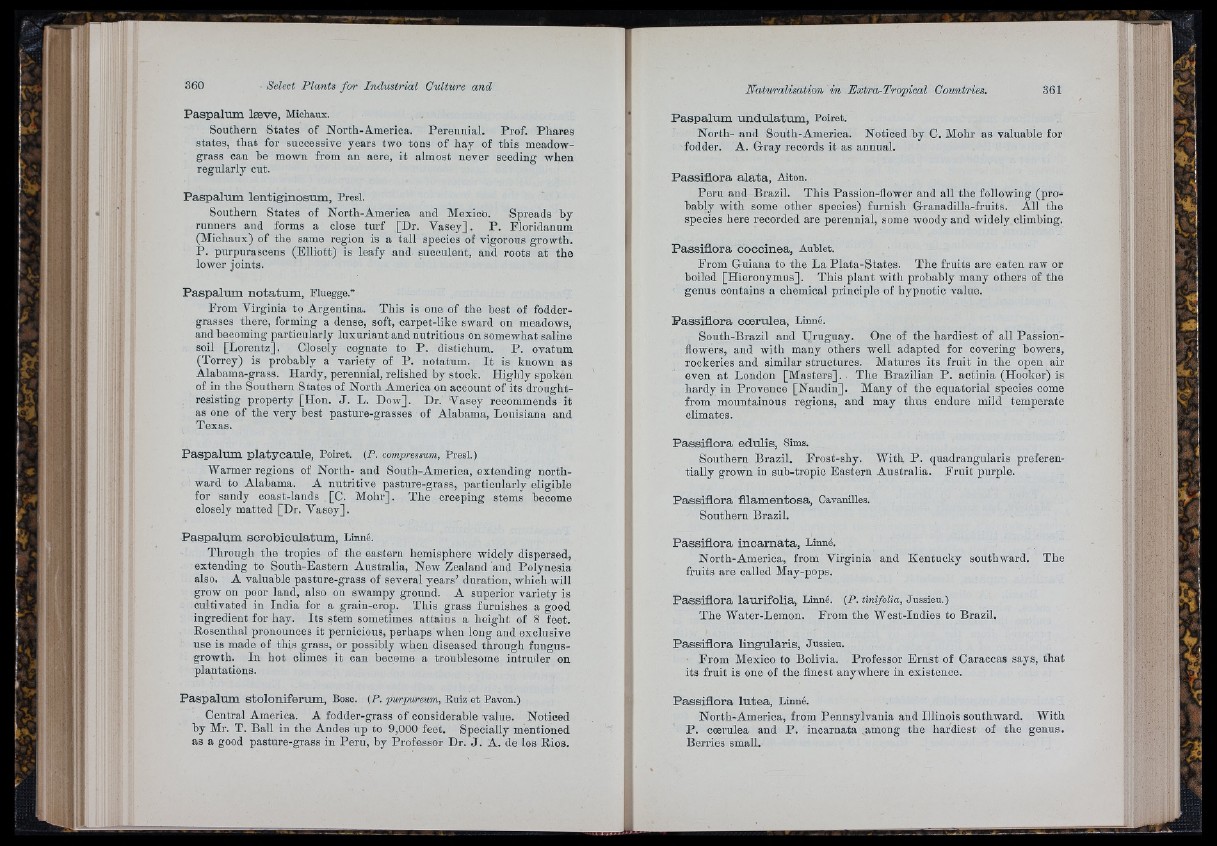
Paspalum læve, Michaux.
Southern States of North-America. Perennial. Prof. Phares
states, that for successive years two tons of hay of this meadow-
grass can be mown from an aere, it almost never seeding when
regularly cut.
Paspalum lentiginosum, Presl.
Sonthern States of North-Amerioa and Mexico. Spreads by
runners and forms a close tu rf [Dr. V a s e y ]. P . Floridauum
(Michaux) of the same region is a tall species of vigorous growth.
P . purpurascens (Elliott) is leafy and succulent, and roots a t the
lower joints.
Paspalum notatum, Pluegge.*
From Virginia to Argentina. This is one of the best of fodder-
grasses there, forming a dense, soft, carpet-like sward on meadows,
aud becoming particularly luxuriant and nutritious on somewhat saline
soil [Lorentz]. Closely cognate to P . distichum. P . ovatum
(Torrey) is probably a variety of P. notatum. I t is known as
Alabama-grass. Hardy, perennial, relished by stock. Highly spoken
of in the Southern States of North America on account of its drought-
resisting property [Hon. J . L. Dow]. Dr. Vasey recommends it
as one of the very best pasture-grasses of Alabama, Louisiana and
Texas.
Paspalum platycaule, Poiret. (P. compressum, Presl.)
Warmer regions of North- and South-America, extending northward
to Alabama. A nutritive pasture-grass, particularly eligible
for sandy coast-lands [C. Mohr]. The creeping stems become
closely matted [Dr. Vasey].
Paspalum scrobioulatum, Linné.
Through the tropics of the eastern hemisphere widely dispersed,
extending to South-Eastern Australia, New Zealand and Polynesia
also. A valuable pasture-grass of several years’ duration, which will
grow on poor land, also ou swampy ground. A superior variety is
cultivated in India for a grain-crop. This grass furnishes a good
ingredient for hay. Its stem sometimes attains a height of 8 feet.
Rosenthal pronounces it pernicious, perhaps when long and exclusive
use is made of this grass, or possibly when diseased through fungus-
growth. In hot climes it can become a troublesome intruder on
plantations.
Paspalum stoloniferum, Bose. (P. purpureum, Ruiz et Pavon.)
Central America. A fodder-grass of considerable value. Noticed
by Mr. T. Ball in the Andes up to 9,000 feet. Specially mentioned
as a good pasture-grass in Peru, by Professor Dr. J . A. de los Rios.
Paspalum undulatum, Poiret.
North- and Sonth-America. Noticed by 0 . Mohr as valuable for
fodder. A. Gray records it as annual.
Passiñora alata, Aiton.
Peru and Brazil. This Passion-flower and all the following (probably
with some other species) furnish Granadilla-fruits. All the
species liere recorded are perennial, some woody and widely climbing.
Passiñora ooccinea, Aublet.
From Guiana to the La Plata-States. The fruits are eaten raw or
boiled [Hieronymus]. This plant with probably many others of the
genus contains a chemical principle of hypnotic value.
Passiñora coerulea, Linné.
South-Brazil and Uruguay. One of the hardiest of all Passionflowers,
and with many others well adapted for covering bowers,
rockeries and similar structures. Matures its fruit in the open air
even a t London [M a ste rs]. The Brazilian P . actinia (Hooker) is
hardy in Provence [Naudin]. Many of the equatorial species come
from mountainous regions, and may thus endure mild temperate
climates.
Passiñora edulis, Sims.
Southern Brazil. Frost-shy. With P . quadrangularis preferentially
grown in sub-tropic Eastern Australia. F ru it purple.
Passiñora filamentosa, Cavanilles.
Southern Brazil.
Passiflora incarnata, Linné.
North-America, from Virginia and Kentucky southward,
fruits are called May-pops.
The
Passiflora laurifolia, Linné. (P. tinifoUa, Jussieu.)
The Water-Lemon. From the West-Indies to Brazil.
Passiflora lingularis, Jussieu.
From Mexico to Bolivia. Professor E rn st of Caraccas says, th a t
its fruit is one of the finest anywhere in existence.
Passiflora lutea, Linné.
North-America, from Pennsylvania and Illinois southward. With
P. coerulea and P . incarnata among the hardiest of the genus.
Berries small.